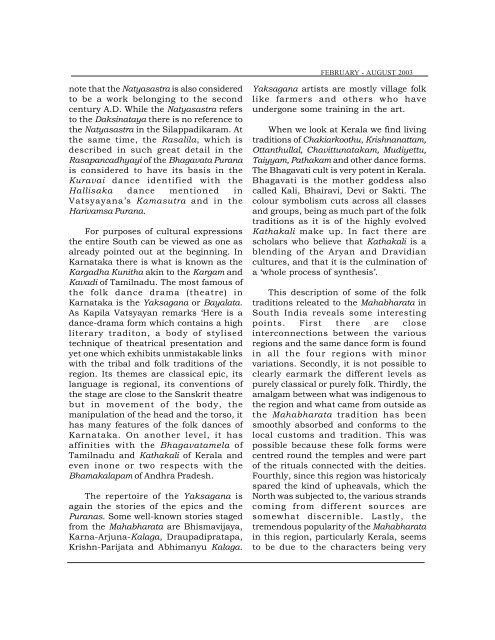Epics in Imprints-1.pdf - Vivekananda Kendra Prakashan
Epics in Imprints-1.pdf - Vivekananda Kendra Prakashan
Epics in Imprints-1.pdf - Vivekananda Kendra Prakashan
You also want an ePaper? Increase the reach of your titles
YUMPU automatically turns print PDFs into web optimized ePapers that Google loves.
note that the Natyasastra is also considered<br />
to be a work belong<strong>in</strong>g to the second<br />
century A.D. While the Natyasastra refers<br />
to the Daks<strong>in</strong>ataya there is no reference to<br />
the Natyasastra <strong>in</strong> the Silappadikaram. At<br />
the same time, the Rasalila, which is<br />
described <strong>in</strong> such great detail <strong>in</strong> the<br />
Rasapancadhyayi of the Bhagavata Purana<br />
is considered to have its basis <strong>in</strong> the<br />
Kuravai dance identified with the<br />
Hallisaka dance mentioned <strong>in</strong><br />
Vatsyayana’s Kamasutra and <strong>in</strong> the<br />
Harivamsa Purana.<br />
For purposes of cultural expressions<br />
the entire South can be viewed as one as<br />
already po<strong>in</strong>ted out at the beg<strong>in</strong>n<strong>in</strong>g. In<br />
Karnataka there is what is known as the<br />
Kargadha Kunitha ak<strong>in</strong> to the Kargam and<br />
Kavadi of Tamilnadu. The most famous of<br />
the folk dance drama (theatre) <strong>in</strong><br />
Karnataka is the Yaksagana or Bayalata.<br />
As Kapila Vatsyayan remarks ‘Here is a<br />
dance-drama form which conta<strong>in</strong>s a high<br />
literary traditon, a body of stylised<br />
technique of theatrical presentation and<br />
yet one which exhibits unmistakable l<strong>in</strong>ks<br />
with the tribal and folk traditions of the<br />
region. Its themes are classical epic, its<br />
language is regional, its conventions of<br />
the stage are close to the Sanskrit theatre<br />
but <strong>in</strong> movement of the body, the<br />
manipulation of the head and the torso, it<br />
has many features of the folk dances of<br />
Karnataka. On another level, it has<br />
aff<strong>in</strong>ities with the Bhagavatamela of<br />
Tamilnadu and Kathakali of Kerala and<br />
even <strong>in</strong>one or two respects with the<br />
Bhamakalapam of Andhra Pradesh.<br />
The repertoire of the Yaksagana is<br />
aga<strong>in</strong> the stories of the epics and the<br />
Puranas. Some well-known stories staged<br />
from the Mahabharata are Bhismavijaya,<br />
Karna-Arjuna-Kalaga, Draupadipratapa,<br />
Krishn-Parijata and Abhimanyu Kalaga.<br />
FEBRUARY - AUGUST 2003<br />
Yaksagana artists are mostly village folk<br />
like farmers and others who have<br />
undergone some tra<strong>in</strong><strong>in</strong>g <strong>in</strong> the art.<br />
When we look at Kerala we f<strong>in</strong>d liv<strong>in</strong>g<br />
traditions of Chakiarkoothu, Krishnanattam,<br />
Ottanthullal, Chavittunatakam, Mudiyettu,<br />
Taiyyam, Pathakam and other dance forms.<br />
The Bhagavati cult is very potent <strong>in</strong> Kerala.<br />
Bhagavati is the mother goddess also<br />
called Kali, Bhairavi, Devi or Sakti. The<br />
colour symbolism cuts across all classes<br />
and groups, be<strong>in</strong>g as much part of the folk<br />
traditions as it is of the highly evolved<br />
Kathakali make up. In fact there are<br />
scholars who believe that Kathakali is a<br />
blend<strong>in</strong>g of the Aryan and Dravidian<br />
cultures, and that it is the culm<strong>in</strong>ation of<br />
a ‘whole process of synthesis’.<br />
This description of some of the folk<br />
traditions releated to the Mahabharata <strong>in</strong><br />
South India reveals some <strong>in</strong>terest<strong>in</strong>g<br />
po<strong>in</strong>ts. First there are close<br />
<strong>in</strong>terconnections between the various<br />
regions and the same dance form is found<br />
<strong>in</strong> all the four regions with m<strong>in</strong>or<br />
variations. Secondly, it is not possible to<br />
clearly earmark the different levels as<br />
purely classical or purely folk. Thirdly, the<br />
amalgam between what was <strong>in</strong>digenous to<br />
the region and what came from outside as<br />
the Mahabharata tradition has been<br />
smoothly absorbed and conforms to the<br />
local customs and tradition. This was<br />
possible because these folk forms were<br />
centred round the temples and were part<br />
of the rituals connected with the deities.<br />
Fourthly, s<strong>in</strong>ce this region was historicaly<br />
spared the k<strong>in</strong>d of upheavals, which the<br />
North was subjected to, the various strands<br />
com<strong>in</strong>g from different sources are<br />
somewhat discernible. Lastly, the<br />
tremendous popularity of the Mahabharata<br />
<strong>in</strong> this region, particularly Kerala, seems<br />
to be due to the characters be<strong>in</strong>g very

















